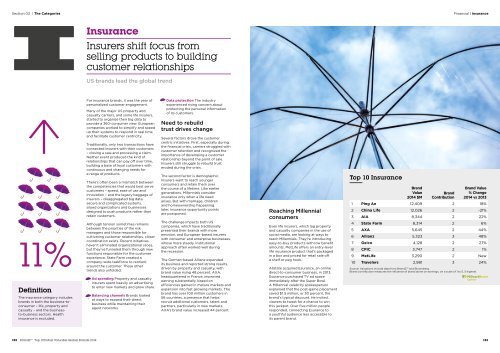download-report
download-report
download-report
Create successful ePaper yourself
Turn your PDF publications into a flip-book with our unique Google optimized e-Paper software.
Section 03 | The Categories<br />
Financial | Insurance<br />
Insurance<br />
Insurers shift focus from<br />
selling products to building<br />
customer relationships<br />
US brands lead the global trend<br />
11%<br />
Definition<br />
The insurance category includes<br />
brands in both the business-toconsumer<br />
– life, property and<br />
casualty – and the businessto-business<br />
sectors. Health<br />
insurance is excluded.<br />
For insurance brands, it was the year of<br />
personalized customer engagement.<br />
Many of the major US property and<br />
casualty carriers, and some life insurers,<br />
started to organize their big data to<br />
provide a 360-consumer view. European<br />
companies worked to simplify and speed<br />
up their systems to respond in real time<br />
and facilitate customer centricity.<br />
Traditionally, only two transactions have<br />
connected insurers with their customers<br />
– closing a sale and processing a claim.<br />
Neither event produced the kind of<br />
relationships that can pay off over time,<br />
building a base of loyal customers with<br />
continuous and changing needs for<br />
a range of products.<br />
There’s often been a mismatch between<br />
the competencies that would best serve<br />
customers – speed, ease of use and<br />
innovation – and the legacy baggage of<br />
insurers – disaggregated big data,<br />
secure and complicated systems,<br />
siloed organizations and businesses<br />
designed to push products rather than<br />
retain customers.<br />
Although tension sometimes remains<br />
between the priorities of the risk<br />
managers and those responsible for<br />
cultivating customer relationships, closer<br />
coordination exists. Recent initiatives<br />
haven’t eliminated organizational siloes,<br />
but they’ve funneled them through new<br />
functions responsible for the customer<br />
experience. State Farm created a<br />
company-wide taskforce to reorient<br />
around the customer. These other<br />
trends also unfolded:<br />
Ad spending Property and casualty<br />
insurers spent heavily on advertising<br />
to enter new markets and grow share.<br />
Balancing channels Brands looked<br />
at ways to expand their direct<br />
business while maintaining their<br />
agent networks.<br />
Data protection The industry<br />
experienced rising concern about<br />
protecting the personal information<br />
of its customers.<br />
Need to rebuild<br />
trust drives change<br />
Several factors drove the customer<br />
centric initiatives. First, especially during<br />
the financial crisis, carriers struggled with<br />
customer retention and recognized the<br />
importance of developing a customer<br />
relationship beyond the point of sale.<br />
Insurers still struggle to rebuild trust<br />
eroded during the crisis.<br />
The second factor is demographic.<br />
Insurers want to reach younger<br />
consumers and retain them over<br />
the course of a lifetime. Like earlier<br />
generations, Millennials consider<br />
insurance only when a life need<br />
arises. But with marriage, children<br />
and homeownership happening<br />
later, insurance opportunity points<br />
are postponed.<br />
The challenge impacts both US<br />
companies, which have traditionally<br />
presented their brands with more<br />
emotion, and European-based insurers<br />
with consumer and enterprise businesses,<br />
whose more steady, institutional<br />
approach often worked well during<br />
the recession.<br />
The German-based Allianz expanded<br />
its business and <strong>report</strong>ed strong results,<br />
driven by property and casualty, with<br />
brand value rising 48 percent. AXA,<br />
headquartered in France, improved<br />
earning substantially, based on<br />
efficiencies gained in mature markets and<br />
expansion into fast growing markets. The<br />
brand has over 100 million customers in<br />
56 countries, a presence that helps<br />
recruit additional customers, talent and<br />
partners, particularly in new markets.<br />
AXA’s brand value increased 44 percent.<br />
Reaching Millennial<br />
consumers<br />
Even life insurers, which lag property<br />
and casualty companies in the use of<br />
social media, are looking at ways to<br />
reach Millennials. They’re introducing<br />
easy-to-buy products with low benefit<br />
amounts. MetLife offers an entry-level<br />
life insurance product that’s packaged<br />
in a box and priced for retail sale off<br />
a shelf or peg hook.<br />
Allstate acquired Esurance, an online<br />
direct-to-consumer business, in 2013.<br />
Esurance purchased TV ad space<br />
immediately after the Super Bowl.<br />
A Millennial celebrity spokesperson<br />
explained that the post-game placement<br />
saved $1.5 million, or 30 percent, the<br />
brand’s typical discount. He invited<br />
viewers to tweet for a chance to win<br />
this jackpot. Over five million people<br />
responded, connecting Esurance to<br />
a youthful audience less accessible to<br />
its parent brand.<br />
Top 10 Insurance<br />
Brand<br />
Value<br />
2014 $M<br />
Brand<br />
Contribution<br />
Brand Value<br />
% Change<br />
2014 vs 2013<br />
1 Ping An 12,409 2 18%<br />
2 China Life 12,026 2 -21%<br />
3 AIA 8,344 2 22%<br />
4 State Farm 8,314 2 6%<br />
5 AXA 5,645 2 44%<br />
6 Allianz 5,323 3 48%<br />
7 Geico 4,128 2 27%<br />
8 CPIC 3,747 2 1%<br />
9 MetLife 3,290 2 New<br />
10 Travelers 2,981 3 24%<br />
Source: Valuations include data from BrandZ and Bloomberg.<br />
Brand contribution measures the influence of brand alone on earnings, on a scale of 1 to 5, 5 highest.<br />
102 BrandZ Top 100 Most Valuable Global Brands 2014 103



